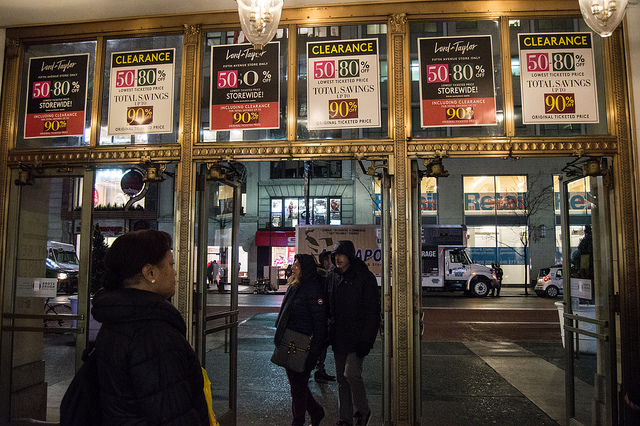Artist rendering of American Dream Mall. courtesy of americandream.com
The days of big department stores with glittering windows and endless racks of product may be slowly coming to end. With a few clicks on a mobile phone, consumers can browse, buy, and ship the same product that could take several hours to find in a store. In the face of this digital boom, brick and mortar stores must find new and intriguing ways to bring customers through the door.
“Given the situation, it may be tempting to cue the Don McLean background music, all the while singing, 2018 is the year retail died!” wrote Jon Croy, CEO and co-founder of Point Inside. “But don’t sound the alarm just yet. There is hope for retailers who are willing to adapt to and embrace the many changes that have evolved consumers’ shopping experience.”
In spite of the closing of approximately 3,800 stores across the United States this year, in New Jersey, development is happening. Triple Five WorldWide, owners of the two largest malls in America, has plans to open a new mall in 2019.
This mall, called “American Dream,” is over 3 million square feet and will take a new approach to shopping as we know it. In an interview with WWD Studios, President and CEO Don Ghermezian described this destination as “unrivaled.”
“American Dream is a curated and thoughtfully designed blend of new-to-market retail, unprecedented entertainment, attractions, world-class dining and culinary experiences, artfully presented in an architecturally exciting and elegant environment like no other,” said Ghermezian.
Just under 5 miles from Manhattan, American Dream is set to be be 55% entertainment and 45% retail, with more than 100 dining options. Entertainment includes a ski park, a water park, a theme park, and more.
At the same time as this massive mega-mall is going up, some giants of retail are going down. Toys ‘R’ Us, Sears, JCPenney, and, most recently, New York City’s iconic Lord & Taylor on 5th Avenue are closing and downsizing on a massive scale.
HBC, parent company of Lord & Taylor, issued a press release in October of 2017 announcing the sale of the flagship store to WeWork Companies. The plan was for WeWork to take over the top floors of the building, but allow Lord & Taylor to keep 150,000 feet for a smaller store on the street level.
“Our partnership with the WeWork team creates new opportunities for HBC to redefine the traditional department store by extending those communities and drive additional traffic to our stores, particularly as we add co-working and community space to existing, vibrant retail locations” said Baker.
But that is no longer the case. Lord & Taylor now plans to close the entire storefront and leave its 5th Avenue home of 104 years for good.

New York City’s iconic Lord and Taylor on 5th Avenue is closing early in 2019. As the holiday season comes to a close, shoppers are scavenging through what is left in the store. Photo by Samantha Springer.
Lord & Taylor is not the only department store in trouble. Sears Holdings Corporation filed for Chapter 11 Bankruptcy in October and announced they will be closing 188 unprofitable KMart and Sears stores by the end of the year.
Macy’s has also taken a body blow. They have closed 81 brick and mortar stores.
This decline has been attributed, in part, to the rise in online shopping.
Since 2010, E-commerce sales in the United States have more than doubled. A report from the Census Bureau states that total E-commerce sales were less than $170 billion in 2010; by 2016 that number had reached just under $390 billion.
The ease of online shopping is a huge driving factor in this uptick.
Emma Manning is an associate of Marketing and Partnerships at Rank & Style, a media site that publishes daily “Top 10” lists in fashion, beauty, and lifestyle. Though the company is relatively new, their site is seeing approximately 14 million viewers per month. Manning attributes this to the time saving service they are providing their visitors.
“With Rank & Style, our readers come to us because they are typically busy, working adults or mothers, who just don’t have the time in their week to go in-store and purchase new items” said Manning.
Another big consumer draw to online shopping is that you can usually find what you’re looking for.
Ramon Garcia wanted to do his Black Friday shopping in person this year. Even though the online marketplace offered the same discount as the store, Garcia Ramon made the trek to look for his Sonos Beam, but was forced to walk away empty-handed.
Even with what seems to be the upper-hand, this digital boom may not be responsible for the apparent decline in brick and mortar stores. Less than 10% of all retail sales in the 3rd Quarter of 2018 were a direct result of online shopping.
Despite the impending doom of major staples of American commerce, not everyone has lost hope. The success of the mega-mall, American Dream, remains to be seen. But in the meantime, smaller brick and mortar stores may still be able to cash in on customer experience.
In an article for Forbes, market researcher Pamela Danziger said, “The human element in retail is the most important factor in attracting customers and driving sales in-store, not product.”
Stephen Choi, a longtime resident of New York, doesn’t need a waterpark to enjoy the experience of shopping in a store. He likes to be in the moment, surrounded by other people in the same state of mind, and to see and feel the things he may buy.
“I love the buzz,” said Choi. “I love the hustle and the bustle. I like people around me, and it feels like a holiday.”

